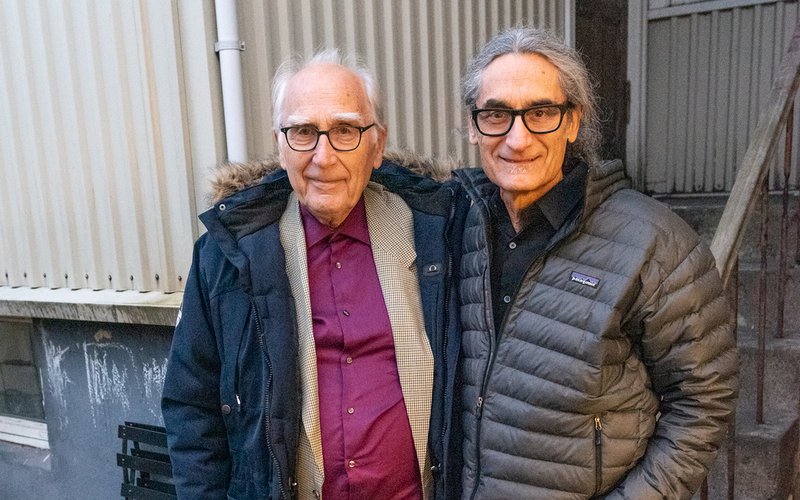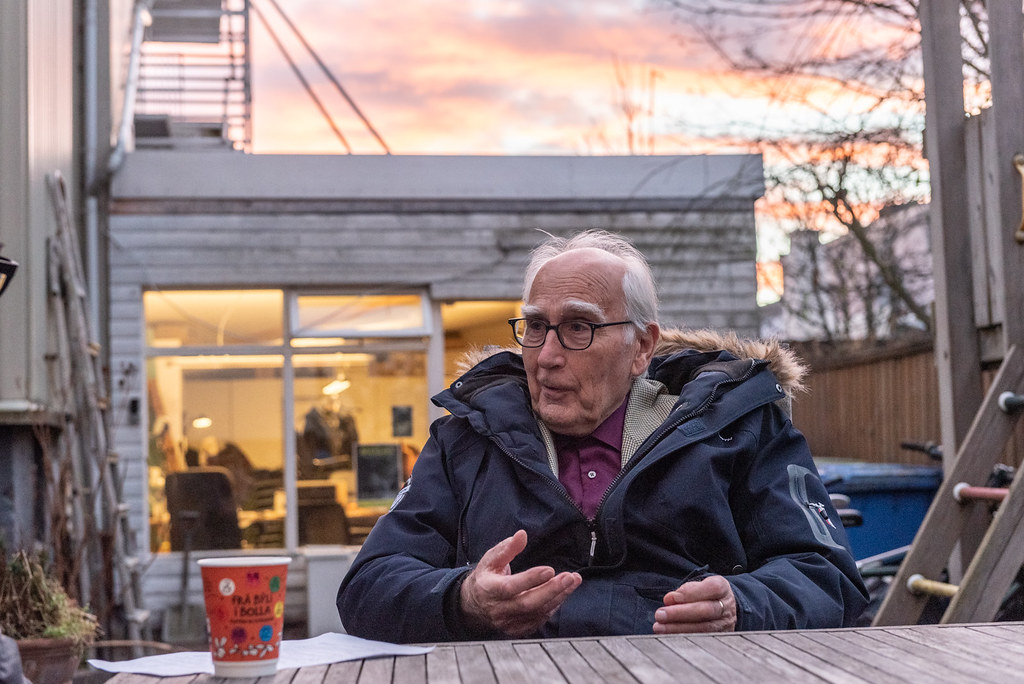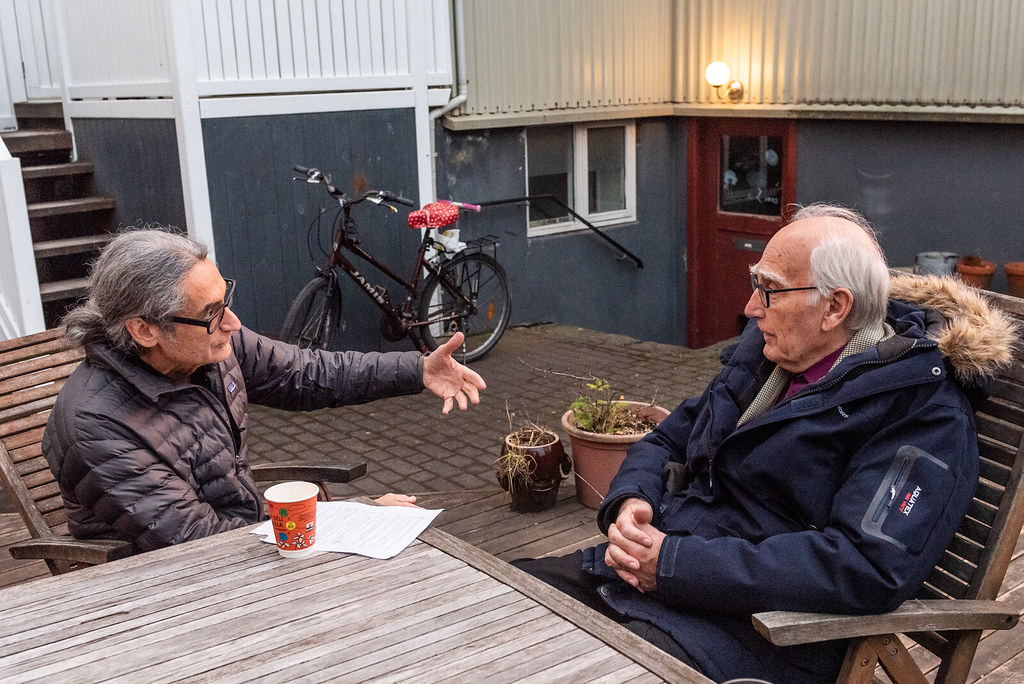
The sun begins to set over the back patio of Mengi, an arts venue in Reykjavik, Iceland. Throughout the day, artists have intermittently performed tributes to the late Icelandic composer Jóhann Jóhannsson who tragically died in 2018. Among the performers earlier in the day was Jóhan Gunnarsson – Jóhannsson’s father.
The elder Jóhann paid homage to his son with a stirring performance of Jóhannsson’s theme for the Stephen Hawking biopic The Theory of Everything, performing on a modified street organ that played MIDI music files created by his son and accompanied by a string quartet. As expected, Gunnarsson’s performance was one of the most beautiful and emotional wrenching moments of the day. Graciously, Gunnarson was still open to discussing his son’s work and legacy.
Sitting at a wooden table in the back patio as the sky turned from blue to an amber glow, bundled up in a winter coat, Gunnarsson spoke with KEXP DJ Kevin Cole. Through their conversation, we also learn more about Gunnarson himself – whom Jóhannsson would fondly cite as an inspiration in his music and experimental pursuits – and the work he did with the first computer in Iceland as an IBM engineer. Gunnarsson also shares some memories of his son’s childhood and his early proclivity toward music.
Read the full exchange and watch a video of their interview below.
KEXP: Jóhann, in so many interviews with your son that I've read or have done personally, he described you as a real influence on him. He said that you're a musician and music lover yourself and that there was always a diverse mix of records around the house. Can you tell me about your love for music and where that originated from?
Jóhann Gunnarsson: Well, I think it comes from my father. He was an amateur musician loved singing and played the violin when [he was] young which was not very common in Iceland at that time. And then when I was about 10, he bought a reed organ which he intended my brothers would learn to play. My younger brother did a little bit, but I didn't quite get it. That organ actually is in Jóhann's studio right now, in Berlin now. So he inherited that from his grandfather.
Did he use that in any of his recordings?
He did yes. I don't know exactly where, but I know that he made some recordings. Also, while he was in Iceland -- he had it in his studio in Reykjavik as well.
In addition to playing music, you've actually built your own instruments.
Yes.
When did you start building them?
Well, I'll tell you when I got the idea. Many years ago, during the years between 1965 and 70, I was quite often in London, England for an extended period, maybe four weeks at least. I attended concerts a lot. There was one time I heard that the "Symphony for Organ" by [Charles-Marie] Widor which fascinated me so that I have never been the same after that. I started thinking about organs out there, looking at how they are made and saw it might be possible to build an organ myself. So then I waited. In 2011, when we both settled down and we're not working anymore, my wife and I, and were living in a very nice house. I said to myself, "it's now or never to start."
Wow, that's amazing. So you didn't actually start building instruments until you retired?
No.
And what was it about that performance that moved you so much?
The organ is a magnificent instrument. To hear what one guy got out of that on this symphony by Widor is really a masterpiece. It's magnificent. I've been fascinated with organs since then.

Tell me about the organ you played today.
The hand organ. This is a German design, designed for amateurs to build. It's a bit complicated. There are a lot of small pieces in it. I did it all myself except I had to buy the relay of course for electronics, the only part I bought out, from Germany, too. Then, of course, there is a lot of help on the Internet from people who have done this before and there is a community about these street organs. So I've benefitted a lot from that. I made another, one of my more primitive ones, which is according to an English design. They both played 20 notes but this one is going to be when it's finished – because it's not finished; it's just put together and made it into a playable state. But there's a lot of work still to be made on it.
It's a work in progress.
Yes, it is.
Is this the wooden pipe organ?
Yes. Yes.
That's at home.
Yeah yeah.
So, when you were building instruments – I guess this happened later if you started in 2011 – did Jóhann have any involvement?
Yeah, he played the organ untested, the first organ. And he liked it very much. It was always his intention to use it for recordings but unfortunately, he did not... He liked the sound of it. He was an organ fan.
When he was growing up, was he always curious and tinkering around with stuff?
Well, he got into music very early. He started when he was about 10. We lived in France for three years and he learned to play the trumpet in school. And then returning home, he continued playing the trombone but very soon got into electronics, synthesizers, and those kinds of things. And from then on there was no return. That was the only thing he was interested in.
He found his passion.
Oh yes.

Now, you were an engineer at IBM from the late 50s into the early 80s. Is it true that the first computer in Iceland was the IBM 1401?
Yes.
And you were the Mechanical Engineer?
I was, yes.
What was that like for the first computer to come here and for you as a programmer?
It was interesting. It was an adventure really. Information Age started actually by that one. I think what you're getting at is, when did we start performing music on it? (laughs)
Yeah, I mean, what I've heard is you discovered an electromagnetic leak, basically?
Yeah, well, I didn't discover it. They had already discovered it in Germany when I went there to learn how to repair the machine. It was a program that could do this, but it was not a very good program and I had to fix it. So I had to learn programming and reverse engineer the program more or less in order to fix it. And I managed to do that. It was nice to have the music because people wanted to see the computer and to see a computer doing regular work. So it was nice to have something else to let people hear.
Do you think that made it feel more human?
Yes, I'm sure it did.
So, you reprogrammed it or backward engineered it and programmed it to play music instead of just emitting sounds that were disturbing radio frequencies. How difficult was it to create melodies, and to program melodies, and how long did it take to do something like that at that time?
It took some time. I don't remember anymore how long, but it took some time. It was tedious work, too. There was another guy, a programmer who participated who came here from America and that was a musician also. He made a program that made it that easy to enter melodies into that machine. It was not perfect but you could you could do things with it.

Describe what it was about the IBM 1401 that created an emotional bond, like the that people who worked with it had a real emotional bond with that computer.
Well, we had worked with it quite intensively for seven years from 1964 when it came to Iceland until '71 actually, when it was taken out of service. Well, it was the first computer and we just loved it. (Laughs.) Very simple.
Well, it was that love for that computer and the music that you actually created on that computer.
It was both, it was. There's one thing, maybe, about computers at that time. You could understand the computer and how it worked down to the transistor. Which is not the case anymore. Now it's just a box, and if there's a failure, you throw away the box. But we had two extreme cases to do to replace individual transistors, and that meant that you had to understand the machine to the bottom.
That connection you had with that computer and the music that you created was the inspiration for Jóhann's album IBM 1041, A User's Manual. Jóhann described that album as a tribute to you.
Yes.
And you actually collaborated on it as well.
Well, the story is – as you've probably heard – that we recorded the tape in '71 when we took the machine formally out of service. Then in 2002, I think, the guy who did this with me, he was moving and he found the tape. And we thought it might be worthwhile to put it on a more modern media. Jóhann was the guy who could do that for us. And he got interested in it. Also, there was some extra material on the tape because the tape that we used was an instructional tape from IBM. So, there are some words on it, some sentences.
It's a beautiful record and there are those spoken word parts that are geared toward you as a mechanical engineer on how to maintain that.
Yeah, sure, that is the case, but you know, originally this was a work of Jóhann and [vocalist] Erna Omarsdottir. They did this together. And she's a modern dancer, and she's dance and he would have his Hammond organ at the back of the stage.
What was it like to hear your work reimagined or revisited?
Very meaningful to me. It really was ... it's a good feeling.
Yeah, in some way, this record is really about the relationship between man and machine, but also father and son in this case. How does that feel?
Good. I think it made us get more intimate with each other, especially after Jóhann moved to Denmark and then to Germany. We didn't meet very often. He came occasionally home for short periods. He was very busy. But it was an important part of the relationship, his work, definitely. And I appreciate that very much, that it exists as a token.

Growing up, you mentioned after you moved back from France and he had discovered music, he was playing the trombone and he got into synthesizers and started being in punk rock bands or rock bands. His first band Daisy Hill Puppy Farm, that was like '85. He was maybe 15-years-old. Would they practice in the house?
No. They had some garage, I think, where they'd practice.
What was it like then? Was he bringing home music? Would you hear what he was doing?
He was not very open about that. It was a bit different, this rock, and we were not much into rock, his mother and I. But no, he was doing that really on his own.
And then the Kitchen Motors collective is really a remarkable kind of think tank of interdisciplinary artists of all types and all kinds of music. And that is certainly a big part of his legacy that people might not realize: how diverse his musical tastes were. And how I think he really planted a lot of seeds for people to explore and be open to different kinds of sounds.
Oh yeah, he did. He certainly did. But he was not alone in Kitchen Motors, you know. There were other people working with him in that.
KEXP shares videos and reflections from a tribute to the late Icelandic composer, filmed during our 2018 trek to Reykjavik.
A favorite of KEXP, Icelandic artist Jóhann Jóhannsson passed away yesterday, Friday, February 9th, in his Berlin apartment. Cause of death is currently unknown, but authorities are investigating. The award-winning composer was 48-years-old.